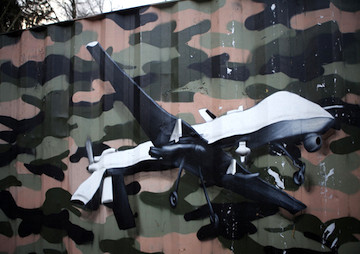An Illegal Military Strategy Disguised as Technological Advance
However they are achieved, the United States has now embraced extrajudicial executions on foreign soil. And most of the discussion has focused more on the new instrument—drone technology—than on its purpose: assassination. thierry ehrmann / CC-BY-2.0
1
2
3
thierry ehrmann / CC-BY-2.0
1
2
3
The Bush administration launched the assassination program in October 2001 in Afghanistan, expanded it in 2002 to Yemen, and went from there. Under Obama, with an actual White House “kill list,” the use of drones has again expanded, this time nine-fold, with growing numbers of attacks in Pakistan, Yemen, Libya, and Somalia, as well as in the Afghan, Iraqi, and Syrian war zones.
There’s an obvious appeal to a technology that allows pilots for the CIA, Joint Special Operations Command, or the Air Force to sit safely in front of video screens in Nevada or elsewhere in the U.S., while killing people half a world away. This is especially true for a president running a global war with a public that does not easily accept American casualties and a Congress that prefers not to be responsible for war and peace decision-making. Drone assassinations have allowed President Obama to spread the “war on terror” to ever more places (even as he quietly retired that phrase), without U.S. casualties or congressional oversight and approval.
One problem has, however, dogged the drone program from the beginning: just like conventional air strikes, remotely targeted missiles and bombs tend to kill the wrong people. Over the last seven years, the count of civilians killed by drones has been mounting. Actual figures are hard to come by, although a number of nongovernmental organizations and journalists have done a good job of collating information from a variety of sources and offering reasonable estimates.
Analysis from all these sources suggests that there are at least three reasons why civilians die in such attacks.
1. The intelligence information on the individual targeted is often wrong. He isn’t where they think he is, or he isn’t even who they think he is. For example, in 2014 a British human rights organization, Reprieve, compiled data on drone strikes that targeted specific individuals in Yemen and Pakistan. According to the Guardian, Reprieve’s work
“indicates that even when operators target specific individuals — the most focused effort of what Barack Obama calls ‘targeted killing’ — they kill vastly more people than their targets, often needing to strike multiple times. Attempts to kill 41 men resulted in the deaths of an estimated 1,147 people, as of 24 November [2014].”
Some of these men were reported in the media as killed multiple times. Even if they didn’t die in the first, second, and in some cases third attempts, other people certainly did. Reprieve also reports one particularly egregious case of mistaken identity:
“Someone with the same name as a terror suspect on the Obama administration’s ‘kill list’ was killed on the third attempt by U.S. drones. His brother was captured, interrogated, and encouraged to ‘tell the Americans what they want to hear’: that they had in fact killed the right person.”
2. There isn’t even a named target. The CIA has long based drone assassination targeting for many missions not on direct intelligence about a particular individual, but on what it calls the “signature” of possible terrorist activity (that is, the behavior or look of people below). Such “signature strikes” target unidentified individuals based on some suspicious activity, usually picked up through drone surveillance. Such a “signature” can be as ill defined as “a gathering of men, teenaged to middle-aged, traveling in convoys or carrying weapons” in countries where many men may be armed. Unfortunately, while such a gathering may indeed indicate some kind of military activity, it may also describe a rural wedding in, say, Yemen, involving driving in convoy from the groom’s town to the bride’s, accompanied sometimes by celebratory gunfire.
Not everyone in the government is convinced that signature strikes are a good idea. In 2012, the New York Times reported this joke at the State Department: “When the C.I.A. sees ‘three guys doing jumping jacks,’ the agency thinks it is a terrorist training camp.”
The fact that signature strikes continue to this day suggests that Secretary of State John Kerry was not entirely truthful when, in 2013, he said at a BBC forum: “The only people that we fire a drone at are confirmed terrorist targets at the highest level after a great deal of vetting that takes a long period of time. We don’t just fire a drone at somebody and think they’re a terrorist.”
3. They were in the way, and so became “collateral damage.” This is the term military theorists regularly use to describe human beings or civilian infrastructure unavoidably destroyed in an attack on a legitimate military target. Of course, a drone operator’s understanding of the term “unavoidable” may be different from that of a woman who has just lost three of her four sons as they were returning home from shopping for supplies to celebrate Eid-al-Fitr, the end of the holy month of Ramadan.
In addition, drone strikes don’t just kill people, including women and children; they also destroy buildings and other property. For example, the Bureau of Investigative Journalism says that, in Pakistan, more than 60% of all strikes target domestic buildings — people’s houses. In other words, “collateral damage” often refers to the destruction of the homes of any survivors of a drone attack.
Your support matters…Independent journalism is under threat and overshadowed by heavily funded mainstream media.
You can help level the playing field. Become a member.
Your tax-deductible contribution keeps us digging beneath the headlines to give you thought-provoking, investigative reporting and analysis that unearths what's really happening- without compromise.
Give today to support our courageous, independent journalists.







You need to be a supporter to comment.
There are currently no responses to this article.
Be the first to respond.